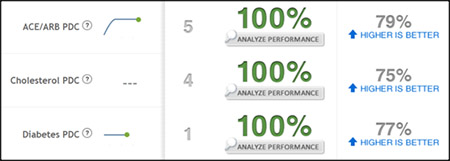Case Study: Improving Adherence Effectively

IMPROVING ADHERENCE EFFECTIVELY, ON A BUDGET
After attending her first McKesson ideaShare meeting in 2010, Parkland Pharmacies pharmacist Lisa Umfleet was inspired to improve her patients' medication adherence rates, specifically taking steps to implement a medication synchronization program.
Challenge
Distances are great in the wide-open spaces of rural Missouri. Geography was proving to be a business challenge for Parkland Pharmacies, which was looking for a way to streamline operations and increase revenues. Inefficient and uncoordinated delivery of multiple medications to customers was proving too costly. Furthermore, customers on multiple medications were finding pickup inconvenient, particularly if they needed to drive to the pharmacy more than once a month. As a result, many patients were late picking up medications or never filled them at all.
Solutions
- Targeted adherence to streamline operations, save money and increase number of scripts filled, bringing in additional revenue
- Used standardized forms and checklists to guide conversations with patients and physicians to identify gaps in care and close the gaps
- Implemented medication synchronization to increase adherence and gain more control over staffing and inventory
- Piloted program with manual appointment-based model vs. new technology due to tight budget
- Focused initially on seniors; later rolled out program to long-term care patients
- In 2011, added manual compliance packaging system (Dispill); upgraded to Parata PASS to help with retail compliance packaging, long-term care and home healthcare agency business
- Synched delivery customers
- Synched drive-through customers
Results: New Store's Adherence Measures in Top 20%
- Parkland's new Ironton store adherence measures are trending in the top 20% of all retail pharmacies
- Parkland's Desloge and Fredrickstown stores have at least two adherence measures that are higher than CMS 5-star goals and Health Mart average
- Medication synchronization program brought in incremental prescriptions and revenue
- Currently 133 patients enrolled in medication synchronization program

Snapshot of EQuIPP dashboard for Parkland's Desloge store from May 2014, which shows two adherence measures above the 5-star goals.

Snapshot of EQuIPP dashboard for Parkland's Fredrickstown store from May 2014, which shows two adherence measures above the 5-star goals.

Snapshot of EQuIPP dashboard for Parkland's new Ironton store from May 2014, which shows measures in the top 20%, though patient count is still low.
HOW TO SUCCEED LIKE PARKLAND PHARMACIES
If you're interested in implementing a manual medication synchronization program, here are some suggested steps:
❑ Get educated
- Take the Implementing Medication Synchronization CE course available on Health Mart University
❑ Review the resources
- Health Mart Operations Manual's Medication Synchronization page
- Links to valuable information for implementing med sync including National Alliance of State Pharmacy Associations (NASPA) Operations Manual for implementing the appointment-based model of medication synchronization, as well as templates and more. Also a link for NCPA members to Simplify My Meds branded med sync program.